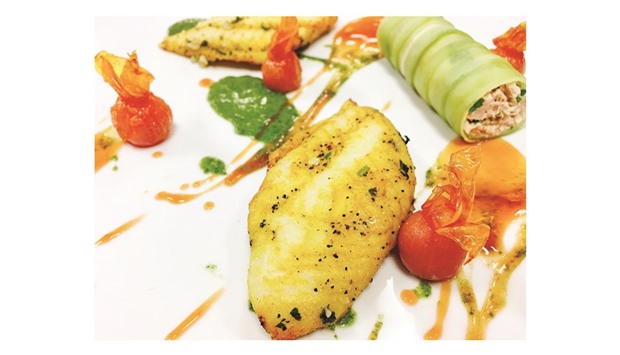Colouration of the Rainbow Trout varies widely in relation to sex, habitat, and maturity. Colours on the back of a trout can range from brown, to olive, to dark blue. All Rainbow Trout have a pinkish band running the length of their body, and a silver underside that fades to a pearl white colour. There are small black spots on their back, fins, and tail.
In general fish is something we should be eating more often of – the oil in the fish provides healthy doses of Omega-3 fatty acids which are essential for a healthy body. Fish also delivers Vitamin D, iodine, magnesium, iron and copper. It’s a good thing for growing bodies.
It is common for healthy and flavoured good foods to be rejected at the dinner table, so the Rainbow Trout is a fish to be introduced in small doses for kids, so that they can acquire a taste for it.
The trout has a mild flavour and a lighter coloured flesh. Rainbow Trout brings back fond memories from my days in Kashmir at The Intercontinental Hotel, where in I used to serve this beautiful and flavourful fish on live counter in sprawling lush green gardens overlooking the famous Dal Lake and snow-clad mountains in the backdrop.
We used to source this fish from Dachigam National Park, 22km from Srinagar, where it was rationed and we as a hotel has a quota for the issue quantity for this fish. This fish was very popular due to its taste and ease in eating. You can easily pull out the comb of bones and make it boneless after cooking.
Rainbow Trout is a popular catch for fishing enthusiasts and one of the best ways to serve it is also simple: dredge it in a little flour, salt and pepper, pan fry and serve on a bed of sautéed vegetables and potato mash.
Trout are members of the salmon family and therefore can grow relatively large. The biggest trout ever caught was in Canada in the year 2009 and weighed around 48 pounds. The average weight of a trout is 2lb to 8lb. Rainbow Trout that migrate to larger bodies of water like the great lakes or oceans can grow much larger and are referred to as “Steel-Heads”.
A distinct character of the Rainbow Trout is an innate desire to return to spawn in the same stream as they were hatched. During spawning season in the spring, a Rainbow Trout will find a secluded cove or inlet. A female will dig a depression in the gravel called a “Redd” where she will lay her eggs. After fertilization, the eggs will hatch in about 21 days. Only a few eggs will live to be adults. The average lifespan for a rainbow trout is 4 to 6 years in the wild. Trout begin spawning at the age of 3 or 4. Spawning season for rainbow trout occurs in the spring water.
Rainbow Trout are predators, and will eat almost anything that they can catch, including insects, small fish, and crustaceans. They will also eat fish eggs, including the eggs of other Rainbow Trout, and will scavenge on leftover carcasses as well. The temperature tolerance of rainbow trout is from 32 to 70 degrees Fahrenheit. Their ideal range is between 55 and 60 Fahrenheit. Fly-fishing is the most popular fishing method for Rainbow Trout.
Freshwater Rainbow Trout is a great choice for dinner because it’s raised in an ecologically responsible way, is replete with B vitamins, and has a soft texture and full flavour that kids naturally like. Most of the Rainbow Trout in America comes from Idaho, where it’s farmed in inland tanks and ponds, so there’s no danger of the fish mingling with native species. In many ways, farmed trout is safer than wild trout, which once proliferated in the Great Lakes but have been over-fished over the past decades.
Lemon Butter
Rainbow Trout
Ingredients
Serves 2
Rainbow Trout fish 2 nos.
Olive oil 1 tbsp
Unsalted Butter 1 tbsp
Garlic paste 1 tsp
Sea salt to taste
Black pepper crushed to taste
Lemon 1 no.
Parsley, chopped 1 tbsp
All-purpose flour 1/2 cup
Garnish
Lemon wedge 2 nos.
Parsley sprigs to garnish
Method
In a bowl, squeeze the lemon juice, add chopped parsley, chopped garlic salt and crushed black pepper to it. Mix well.
Cut the trout fillets into serving size and pat dry, rub the prepared marine to the fish fillets, keep aside.
Heat olive oil and butter in a skillet and lightly dust the fish fillet with flour and place skin side first in the oil.
Turn to cook from other side till the colour is light brown.
Once the fish is cooked, remove and serve hot with sautéed vegetables and steamed rice.
* Chef Tarun Kapoor,
Culinary Mastermind, USA. He may be contacted at [email protected]

